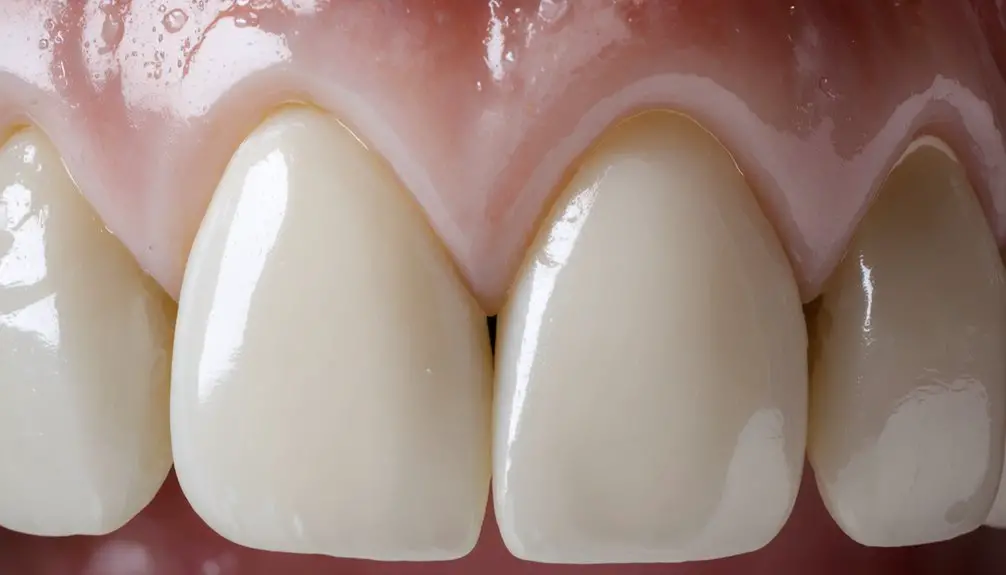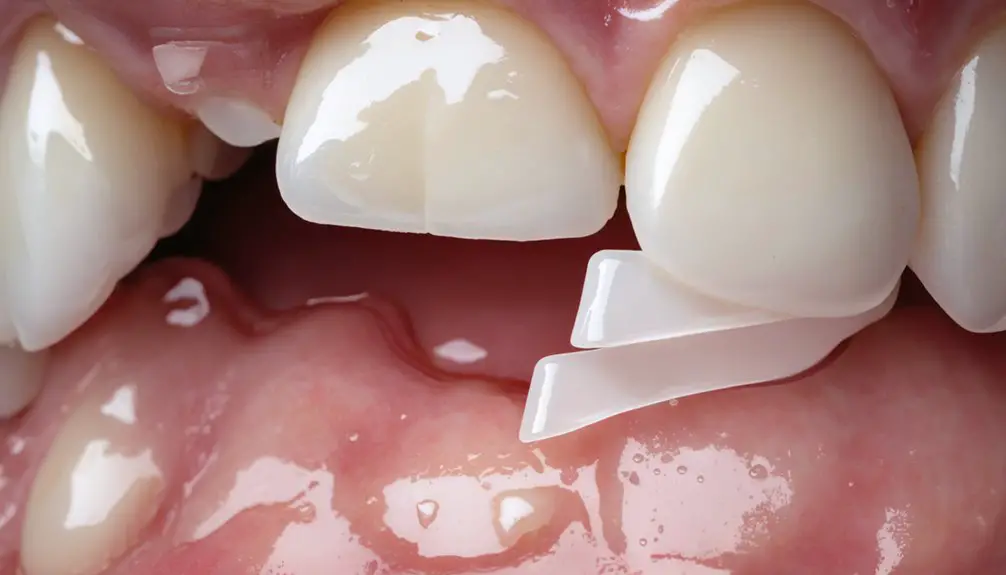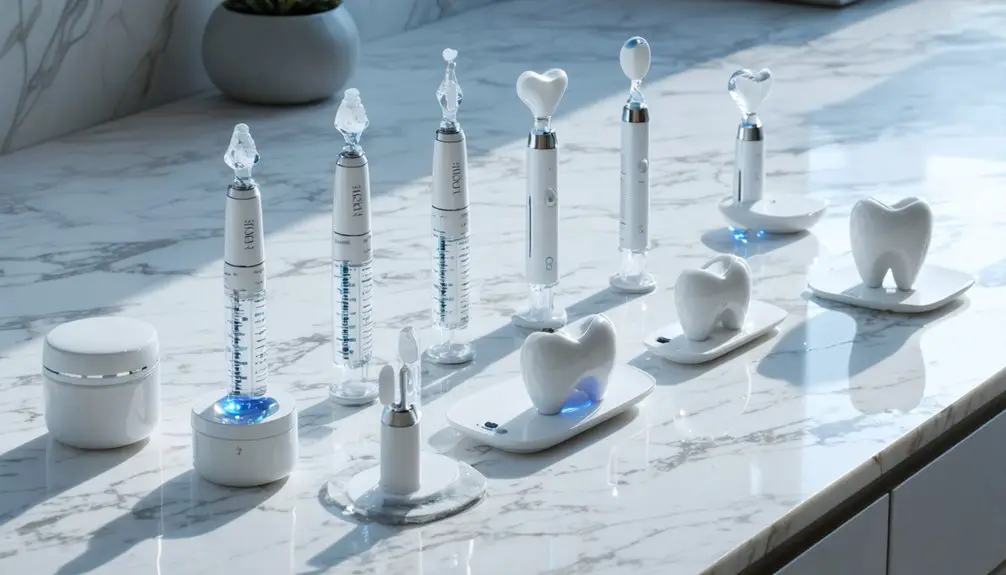Your teeth can become sensitive during whitening because the active ingredients – hydrogen peroxide or carbamide peroxide – penetrate through your enamel and dentin layers to reach the tooth pulp. This creates oxygen bubbles that cause pressure spikes and sharp sensations. The peroxides also form microscopic defects in your enamel, increasing fluid flow through dentinal tubules. Understanding the specific factors that influence sensitivity can help you choose the right whitening approach.
Key Takeaways
- Whitening products contain peroxide compounds that penetrate tooth layers, creating pressure in the pulp and triggering nerve sensitivity.
- Higher concentrations of peroxide cause more intense sensitivity and increase the risk of gum irritation during treatment.
- The whitening process creates microscopic defects in tooth enamel, allowing fluid movement through dentinal tubules and causing discomfort.
- Pre-existing conditions like thin enamel, exposed dentin, or gum recession make teeth more susceptible to whitening sensitivity.
- Extended exposure times and improper tray fit can lead to increased sensitivity and soft tissue irritation.
Understanding the Science Behind Teeth Whitening Sensitivity
When teeth whitening products come into contact with your teeth, their active ingredients – hydrogen peroxide or carbamide peroxide – penetrate the enamel and dentin layers to reach the tooth’s pulp.
These peroxide molecules travel through microscopic tubules in your dentin that lead directly to nerve endings in the pulp tissue.
The sensitivity mechanisms involve two key processes.
Understanding tooth sensitivity requires examining two distinct pathways through which whitening agents affect dental nerves and tissues.
First, when peroxide penetration reaches the pulp, it reacts with catalase enzymes to create oxygen bubbles. These bubbles cause sudden pressure spikes in your pulp chamber, leading to sharp “zinger” sensations. Studies show that 60-90% of patients experience some form of sensitivity during tooth whitening treatments.
Second, the peroxides create microscopic defects in your tooth structure, increasing fluid flow through dentinal tubules. Using a specialized desensitizing toothpaste can help minimize these symptoms during treatment. This process makes your teeth more responsive to temperature changes and pressure, resulting in temporary discomfort that typically resolves once treatment ends.
Common Symptoms and Their Prevalence
During teeth whitening treatments, you’ll likely experience temperature sensitivity and sharp, transient pain that typically peaks within hours of application and affects 50-78% of users.
You may notice these symptoms more intensely if you have gingival recession or exposed dentin, as these conditions make your teeth more susceptible to whitening-induced sensitivity. Using treatments with higher peroxide concentrations can significantly increase your risk of experiencing tooth sensitivity. Most patients can expect soft-tissue irritation occurring in nearly half of all treatments.
While most users experience mild discomfort that resolves within 24-48 hours, approximately 14% of people discontinue treatment due to severe sensitivity symptoms.
Types of Sensitivity Experienced
Most users of teeth whitening kits experience some form of sensitivity, with studies showing that approximately 68% of individuals report discomfort during or after treatment.
The most common type is mild sensitivity, affecting 54% of users who describe it as slight discomfort. Moderate sensitivity occurs in about 10% of cases, while severe sensitivity impacts roughly 4% of users. The reason for this sensitivity often involves dentinal microtubules becoming exposed.
You’ll typically notice these symptoms as sharp or aching responses to temperature changes, particularly when consuming hot or cold items. The active ingredient hydrogen peroxide in whitening products is the primary cause of this sensitivity.
The discomfort may manifest as throbbing sensations or increased sensitivity to pressure on your treated teeth. Some users also experience tingling or prickling sensations, often accompanied by gum discomfort or mild inflammation.
These symptoms usually resolve within two to four weeks as your enamel naturally remineralizes.
Duration of Discomfort Effects
Teeth whitening sensitivity follows a predictable timeline, with most patients experiencing peak discomfort immediately after treatment that diminishes considerably within 24 hours.
You’ll typically notice sensitivity lasting anywhere from a few days to a week, with most cases resolving within two weeks.
During your discomfort timeline, you may experience temperature sensitivity to hot and cold stimuli, along with sharp, transient pains or dull aches. Using desensitizing toothpaste regularly can help minimize these symptoms.
Research shows that 30-78% of patients report some level of sensitivity, though it’s usually mild to moderate.
The sensitivity duration largely depends on the concentration of whitening agents used – higher peroxide levels (35-40%) tend to cause more intense and longer-lasting discomfort compared to lower concentrations (10%).
For ideal comfort, consider treatments that combine lower peroxide levels with shorter exposure times.
Who Gets Most Affected
When it comes to teeth whitening sensitivity, certain individuals face a markedly higher risk of discomfort. If you have gingival recession, exposed dentin, or pre-existing tooth sensitivity, you’ll likely experience more intense reactions to whitening treatments. Most whitening products contain hydrogen peroxide or carbamide as their active ingredients.
Studies show that 43.2% of patients report discomfort during the whitening protocol, with sensitivity affecting up to 78% of users in some cases.
You’re particularly vulnerable if you’re using high-concentration peroxide products or if you’re an older adult with natural enamel wear. Sensitive individuals typically experience sharp, transient pain in response to temperature changes or sweet substances.
While most cases remain mild to moderate, about 13.8% of patients stop treatment due to discomfort. Your saliva flow rate can also impact sensitivity – those with good salivary flow tend to experience fewer issues.
How Product Ingredients Impact Tooth Sensitivity
When you’re choosing a teeth whitening kit, you’ll find that higher peroxide concentrations increase your risk of sensitivity while offering faster results.
Many products now include desensitizing agents like potassium nitrate or fluoride to counteract the discomfort caused by peroxide penetration into tooth structures. Aggressive brushing with whitening products containing abrasives can also damage tooth enamel and worsen sensitivity issues.
The length of time your teeth are exposed to whitening gels also plays a vital role in sensitivity development, which is why following product instructions precisely helps balance effectiveness with comfort. Research has shown that whitening products with 35% hydrogen peroxide consistently trigger sensitivity in patients.
Peroxide Strength Affects Discomfort
Research consistently demonstrates that peroxide concentration plays an essential role in tooth sensitivity during whitening treatments. Higher concentrations between 35-40% hydrogen peroxide typically cause more intense discomfort, while lower concentrations of 10-16% carbamide peroxide result in milder sensitivity levels.
The relationship between peroxide strength and sensitivity stems from how deeply these agents penetrate your tooth structure.
- Higher peroxide concentrations (35-40%) cause more severe sensitivity but offer faster whitening
- Lower concentrations (10-16%) produce gentler results with minimal discomfort
- Carbamide peroxide breaks down more slowly than hydrogen peroxide, reducing sensitivity risk
- Treatment duration combined with peroxide strength directly impacts your comfort level
Understanding these relationships helps you choose a whitening method that balances effectiveness with comfort.
Desensitizing Agents Fight Pain
Modern whitening products incorporate powerful desensitizing agents to combat tooth sensitivity during treatment. The most effective ingredients include potassium nitrate, which calms dental nerves by blocking pain signals, and fluoride, which strengthens enamel while sealing microscopic tubules in dentin. These work together to minimize discomfort during and after whitening.
Strontium chloride and Pro-Argin technology provide additional nerve-calming benefits by occluding dentin pathways that transmit pain. You’ll find these ingredients carefully balanced within whitening gel formulations, as internal inclusion proves more effective than separate application.
Many products now combine multiple desensitizing agents at ideal concentrations – like 5% potassium nitrate with enhanced fluoride levels – to guarantee you can achieve brighter teeth while maintaining comfort throughout the whitening process.
Gel Contact Time Matters
The duration of teeth whitening gel contact considerably influences both treatment effectiveness and sensitivity risk. When you exceed recommended gel exposure duration, you’ll increase enamel permeability and potentially trigger tooth sensitivity without gaining additional whitening benefits.
- Keep whitening sessions with 35% carbamide peroxide to 20-30 minutes to protect your enamel while achieving ideal results.
- Start with shorter exposure times and gradually increase duration to minimize sensitivity development.
- Avoid wearing trays longer than 1 hour per day, as extended contact can cause microscopic enamel changes.
- Allow 24-72 hours between whitening sessions if sensitivity occurs, as this gives teeth time to recover from increased porosity.
Following these timing guidelines helps maintain enamel integrity while achieving desired whitening results for your patients.
Key Risk Factors for Experiencing Discomfort
While many people pursue teeth whitening for a brighter smile, several key factors can increase your risk of experiencing discomfort during treatment.
High peroxide concentrations and prolonged exposure times are major risk factors, as they allow bleaching agents to penetrate deeper into your tooth structure.
The higher the peroxide content and longer the treatment time, the greater your risk of teeth sensitivity from deep bleach penetration.
If you have pre-existing sensitivity or compromised gum health, you’re more susceptible to discomfort triggers during whitening.
Ill-fitting trays that allow gel contact with gums can cause irritation and heightened sensitivity.
Frequent treatments without adequate recovery time between sessions may lead to cumulative enamel wear.
Your individual tooth structure and susceptibility to sensitivity also play vital roles in determining how you’ll respond to whitening treatments.
Using products with higher peroxide levels increases your likelihood of experiencing temporary nerve inflammation and dentin exposure.
The Role of Dental Structure and Health

Understanding dental structure provides key insights into why sensitivity occurs during teeth whitening treatments. Your dental structure’s health, particularly enamel health, plays a vital role in how your teeth respond to whitening agents.
When peroxide-based whiteners penetrate your enamel, they can reach the dentin layer where nerve endings reside, potentially causing discomfort.
- Your enamel’s thickness and integrity act as natural barriers – healthier enamel better protects against whitening agent penetration.
- Exposed dentin tubules, especially from gum recession, create direct pathways to nerve endings.
- Pre-existing conditions like cracks or erosion increase your risk of sensitivity.
- Your tooth’s pulp chamber size and dentin thickness influence how intensely you’ll experience sensitivity responses.
Practical Tips to Reduce Whitening Sensitivity
Managing sensitivity during teeth whitening requires a strategic approach to minimize discomfort and maximize results.
Start using desensitizing toothpaste at least one week before treatment and continue for up to two weeks after to block nerve pathways effectively.
Desensitizing toothpaste creates a protective barrier, making teeth whitening more comfortable when used before and after your treatment.
You’ll need to avoid temperature extremes for 48 hours post-treatment, sticking to room-temperature beverages to prevent sharp pain responses.
Stay away from acidic foods and sugary items that can erode enamel; instead, choose calcium-rich alternatives to support remineralization.
Practice gentle hygiene by using a soft-bristled toothbrush with circular motions, and consider incorporating fluoride treatments for added protection.
When brushing, use lukewarm water and maintain consistent yet gentle pressure to protect your newly whitened teeth.
Frequently Asked Questions
How Long Should I Wait Between Professional Dental Cleanings and Starting Whitening Treatments?
90% of patients experience ideal whitening results when starting immediately after cleaning. You’ll get the best dental care outcomes by beginning your whitening treatment right after or within a few days of professional cleaning.
Can Certain Medications Increase Sensitivity When Using Teeth Whitening Products?
Yes, medications’ effects can considerably increase tooth sensitivity during whitening. Some drugs trigger sensitivity by causing dry mouth, altering nerve responses, or weakening enamel protection when combined with whitening agents.
Are Natural Teeth Whitening Alternatives Less Likely to Cause Sensitivity?
Natural remedies like baking soda and activated charcoal considerably reduce sensitivity levels compared to peroxide-based options, since they don’t penetrate deeply into your tooth structure.
Does Teeth Sensitivity From Whitening Indicate Permanent Damage to Dental Health?
No, sensitivity from teeth whitening doesn’t indicate permanent dental health damage. While you’ll experience temporary discomfort, studies show the effects are reversible when you follow proper whitening protocols.
Should I Avoid Whitening if I Have Dental Crowns or Veneers?
Like Sarah’s experience, you’ll want to be cautious with whitening options. Since dental materials in crowns and veneers don’t respond to bleaching, you’ll end up with mismatched colors. Consult your dentist for alternatives.
References
- https://pubmed.ncbi.nlm.nih.gov/12198987/
- https://crest.com/en-us/oral-care-tips/teeth-sensitivity/teeth-whitening-sensitivity-causes-how-to-avoid-it
- https://familydentistchandler.com/how-to-avoid-teeth-sensitivity-after-whitening/
- https://harrisburgsmilesdental.com/why-does-teeth-whitening-cause-sensitivity-understanding-the-basics/
- https://www.blvddentistry.com/can-you-get-whitening-treatment-with-sensitive-teeth/
- http://www.korwhitening.com/wp-content/uploads/2016/09/MKT-70-1045-Rev-1-Sensitivity-Science-Paper.pdf
- https://fomm.amegroups.org/article/view/66778/html
- https://pmc.ncbi.nlm.nih.gov/articles/PMC6784469/
- https://pmc.ncbi.nlm.nih.gov/articles/PMC4058574/
- https://www.covaneydental.com/the-science-behind-the-sparkle-understanding-teeth-whitening-methods/



